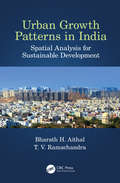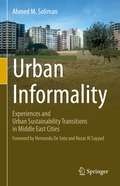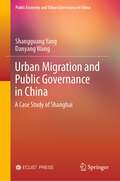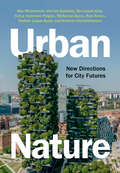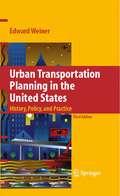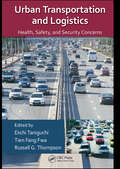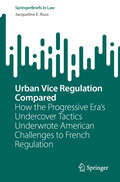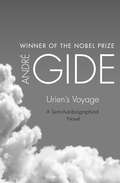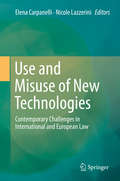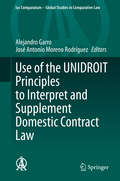- Table View
- List View
Urban Growth Patterns in India: Spatial Analysis for Sustainable Development
by Bharath H. Aithal T. V. RamachandraThis book uses spatio-temporal analysis to understand urbanisation in Indian cities and explain the concept and impact of global greenhouse gas (GHG) emissions. It creates a GHG footprint for Indian cities and engages in a discussion about the United Nations Sustainable Development Goals (SDGs) and smart city initiatives within an Indian context. Understanding the spatial patterns of land use/land cover (LULC) dynamics in the rapidly urbanising cities of India, the readers will be able to simulate future urbanisation patterns and use spatial temporal analysis as a tool for implementing appropriate mitigation measures. Features Analyses the complete urbanisation and urban sprawl of major cities in India using advanced geospatial modelling techniques Highlights the best practices and methods used in modelling urban growth Discusses greenhouse gas emissions from various sectors and their effects in local environments Addresses the increase of local temperature in cities due to unplanned land use change and its impact on environmental sustainability and resilience Fills the need for data-driven governance and policy decisions by introducing various analyses through spatial mapping Highlighting some of the best practices and tools being used for modelling urban growth through case studies, the book is useful to those interested in using new technologies and methods for data collection and problem solving. It focuses on the major environmental issues in India, which are prevalent in most developing countries.
Urban Housing Segregation of Minorities in Western Europe and the United States
by Wim Blauw Elizabeth Huttman Juliet SaltmanThis book provides an expert examination and comparison of housing segregation in major population centers in the United States and Western Europe and analyzes successes and failures of government policies and desegregation programs in the United States, the United Kingdom, the Netherlands, Sweden, France, and West Germany.The collection begins with a review of the historical development of housing segregation in these countries, describing current housing conditions, concentration of housing in each country's leading cities, minority populations and the housing they occupy--specifically public, nonprofit, and owner-occupied dwellings. When focusing on the United States, the contributors assess housing segregation, antisegregation measures, and institutional racism toward blacks in the Midwest and South, and toward Mexican-Americans throughout American cities. Chapters dealing with Western Europe include housing segregation of South Asian and West Indian immigrants in Britain, immigrants in Sweden, Turkish, and Yugoslav "guest workers" in West Germany, and Algerian and other Arab groups in France. The book concludes with discussions of public housing policies; suburban desegregation, resegregation, and integration maintenance programs; specific integration stabilization programs; and desegregation efforts in one specific place.Contributors. Elizabeth Huttman, Michal Arend, Cihan Arin, Maurice Blanc, Wim Blauw, Ger Mik, Clyde McDaniels, Jürgen Friedrichs, Hannes Alpheis, John M. Goering, Len Gordon, Albert Mayer, Rosemary Helper, Barry V. Johnston, Terry Jones, Valerie Karn, Göran Lindberg, Anna Lisa Lindén, Deborah Phillips, Dennis Keating, Juliet Saltman, Alan Murie
Urban Informality: Experiences and Urban Sustainability Transitions in Middle East Cities
by Ahmed M. SolimanThis professional book introduces an analytical framework of urban informality perspectives in the Middle East that is aligned with the Global South. The context of Egypt, Lebanon, and Jordan—in the Middle East— is the transregional focus of this book. In these contexts, the book opens a new arena of academic discussion on the theory and practice of urban informality.Urban Informality: Experiences and Urban Sustainability Transitions in Middle East Cities questions urban informality, "as a site of transitions", interrelated and interlinked with urban sustainability transitions in speedy changes in a given environment. The book presents ‘urban informality sustainability transitions’ regarding resilience and adaptability that require shifts in urban systems. Shifts from a static process to a dynamic process that eradicates the fragmentation between the tensions, anxieties, and pressures of four modes of production, reproduction, consumptions, and distribution of goods and services in the city and its practices. Finally, through eleven chapters, the concluding remarks explore to what extent and how can urban informality transitions be sustainable.
Urban Life in Delhi Slums: Stories of Community Solutions and Resilience (Routledge Studies in Cities and Development)
by Steve Humble Pauline DixonThis book investigates urban life in the slums of Delhi, demonstrating how individuals and communities self-organise to solve problems that arise in their neighbourhoods.Around one-quarter of the world’s urban population live in informal, slum and squatter settlements, representing a significant economic and cultural force. Despite this, settlements are often perceived as marginal, homogenous places, overlooking the resilience and agency of the diverse actors, networks and social groups working collectively within them. This book draws on extensive qualitative and quantitative data from squatter and resettlement colonies in and around Delhi, foregrounding the voices of residents to build a bottom-up picture of place and urban development. The book analyses the contexts in which households operate within their communities and the adaptiveness of individuals living in different slum types, with differing levels of governance. In doing so, the book demonstrates the effect which different institutional agreements and governance systems have on enterprise, empowerment, resilience, trust, dignity and engaging in life that has purpose and meaning.This book’s detailed assessment of slum spaces and networks will be of interest to researchers across a range of fields, including international development, geography, urban planning, politics and sociology, as well as to policy makers and civil society organisations.
Urban Life in Post-Soviet Asia
by Caroline Humphrey Victor Buchli Catherine AlexanderCapturing a unique historical moment, this book examines the changes in urban life since the collapse of the Soviet Union from an ethnographic perspective, thus addressing significant gaps in the literature on cities, Central Asia and post-socialism. It encompasses Tashkent, Almaty, Astana and Ulan-Ude: four cities with quite different responses to the fall of the Soviet Union. Each chapter takes a theme of central significance across this huge geographical terrain, addresses it through one city and contextualizes it by reference to the other sites in this volume. The structure of the book moves from nostalgia and memories of the Soviet past to examine how current changes are being experienced and imagined through the shifting materialities, temporalities and political economies of urban life. Privatization is giving rise to new social geographies, while ethnic and religious sensibilities are creating emergent networks of sacred sites. But, however much ideologies are changing, cities also provide a constant lived mnemonic of lost configurations of ideology and practice, acting as signposts to bankrupted futures. Urban Life in Post-Soviet Asia provides a detailed account of the changing nature of urban life in post-Soviet Asia, clearly elucidating the centrality of these urban transformations to citizens’ understandings of their own socio-economic condition.
Urban Migration and Public Governance in China: A Case Study of Shanghai (Public Economy and Urban Governance in China)
by Shangguang Yang Danyang WangThis book, focusing on urban migration and public governance, reviews on the concepts and theories of urban migration and urban governance across the globe and sums up world migration trends and policy changes, coupled with the characteristics and types of China’s urban migration. What differs this book from other books is that it probes into the main factors and mechanisms influencing urban migration and inclusion, and that it adopts Shanghai as a sample and capitalizes on Shanghai’s urban migration data to verify the subjective and objective reasons affecting urban migrants’ inclusion. Moreover, this book takes a further step to conduct a theoretical reflection from the perspectives of population migration and migration policies and explores current dilemmas facing China in terms of urban migration management and possible ways to make a difference. In the final part, this book puts forward some theory-based and practicable countermeasures to transform urban migration governance in China.
Urban Nature: New Directions for City Futures
by Kes McCormick Bernadett Kiss Yuliya Voytenko Palgan Harriet Bulkeley McKenna Davis Rob Raven Andrés Luque-Ayala Kathrin HörschelmannThis introductory textbook with a global scope aims to train students of geography, sustainability, and urban and environmental studies to re-imagine and transform cities to meet climate, biodiversity, and sustainability challenges. A dedicated team of authors critically examine the relationships between nature and urban areas, sharing an inspiring account of how nature helps us re-think our cities and their futures. Prior to this textbook, literature for courses covering urban nature was written by and for practitioners, whereas this textbook is written by experienced course instructors specifically to be accessible to diverse students. The textbook is illustrated with numerous photos and figures which bring key topics, challenges, and opportunities to life. It contains focus boxes and case studies from every continent, offering students an international scope and multiple entry points into the field. Chapters conclude with thought-provoking follow-up questions and recommended reading. The authors provide an array of supplementary online resources.
Urban Regeneration in the UK
by Andrew TallonThis textbook provides an accessible and critical synthesis of urban regeneration in the UK, incorporating key policies, approaches, issues, debates and case studies. The central objective of the textbook is to place the historical and contemporary regeneration agenda in context. Section I sets up the conceptual and policy framework for urban regeneration in the UK. Section II traces policies that have been adopted by central government to influence the social, economic and physical development of cities, including early town and country and housing initiatives, community-focused urban policies of the late 1960s, entrepreneurial property-led regeneration of the 1980s, competition for urban funds in the 1990s, urban renaissance and neighbourhood renewal policies of the late 1990s and 2000s, and new approaches in the age of austerity during the 2010s. Section III illustrates the key thematic policies and strategies that have been pursued by cities themselves, focusing particularly on improving economic competitiveness and tackling social disadvantage. Section IV summarises key issues and debates facing urban regeneration upon entering the 2020s, and speculates over future directions in an era of continued economic uncertainty. The Third Edition of Urban Regeneration in the UK combines the approaches taken by central government and cities themselves to regenerate urban areas. The latest ideas and examples from across disciplines and across the UK's urban areas are illustrated. This textbook provides a comprehensive and up-to-date synthesis that will be of interest to students, as well as a seminal read for practitioners and researchers.
Urban Surfaces, Graffiti, and the Right to the City
by Sabina AndronThis landmark book focuses on urban surfaces, on exploring their authorship and management, and on their role in struggles for the right to the city. Graffiti, pristine walls, advertising posters, and municipal signage all compete on city surfaces to establish and imprint their values on our environments. It is the first time that the surfacescapes of our cities are granted the entire attention of a book as material, visual, and legal territories. The book includes a critical history of graffiti and street art as contested surface discourses and argues for surfaces as sites of resistance against private property, neoliberal creativity, and the imposition of urban order. It also proposes a seven-point manual for a semiotics of urban surfaces, laying the ground for a new discipline: surface studies. Page after page and layer after layer, surfaces become porous and political and emerge as key spatial conditions for rethinking and re-practicing urban dwelling and spatial justice. They become what the author terms the surface commons. The book will appeal to a wide readership across the disciplines of urban studies, architectural theory and design, graffiti, street art and public art, criminology, semiotics, visual culture, and urban and legal geography. It will also serve as a tool for city scholars, policy makers, artists, and vandals to disrupt existing imaginaries of order, justice, and visibility in cities.
Urban Surfaces, Graffiti, and the Right to the City (ISSN)
by Sabina AndronThis book explores the ownersheir authorship and management, and their role in struggles for the right to the city. Includes a critical history of graffiti and street art as contested surface discourses. Interdisciplinary appeal.
Urban Transportation Planning in the United States: History, Policy, and Practice, 3rd Edition
by Edward WeinerThe development of U.S. urban transportation policy over the past 50 years illustrates the changing relationships among federal, state, and local governments. This comprehensive text examines the evolution of urban transportation planning from early developments in highway planning in the 1930s to today's concerns over sustainable development, security, and pollution control. Focusing on major national events, the book discusses the influence of legislation, regulations, conferences, federal programs, and advances in planning procedures and technology. The book focuses in-depth at the most significant event in transportation planning--the Federal-Aid Highway Act of 1962; creating a federal mandate for a comprehensive urban transportation planning process carried out cooperatively by states and local governments with federal funding, this act was crucial in the spread of urban transportation. Claiming that urban transportation planning is more sophisticated, costly, and complex than its highway and transit planning predecessors, the book demonstrates how urban transportation planning evolved in response to changes in such factors as environment, energy, development patterns, intergovernmental coordination, and federal transit programs. It further illustrates how broader concerns for global climate change and sustainable development have braided the purview of transportation planning. This fully updated, revised, and expanded edition highlights the dynamics of transportation planning post-9/11, covers the impact of recent legislation, emphasizes such timely issues as security, oil dependence, performance measurement, and public-private sector collaboration.
Urban Transportation Planning in the United States: History, Policy, and Practice, 4th Edition
by Edward WeinerThe development of U.S. urban transportation policy over the past 50 years illustrates the changing relationships among federal, state, and local governments. This comprehensive text examines the evolution of urban transportation planning from early developments in highway planning in the 1930s to today's concerns over sustainable development, security, and pollution control. Focusing on major national events, the book discusses the influence of legislation, regulations, conferences, federal programs, and advances in planning procedures and technology. The book focuses in-depth at the most significant event in transportation planning--the Federal-Aid Highway Act of 1962; creating a federal mandate for a comprehensive urban transportation planning process carried out cooperatively by states and local governments with federal funding, this act was crucial in the spread of urban transportation. Claiming that urban transportation planning is more sophisticated, costly, and complex than its highway and transit planning predecessors, the book demonstrates how urban transportation planning evolved in response to changes in such factors as environment, energy, development patterns, intergovernmental coordination, and federal transit programs. It further illustrates how broader concerns for global climate change and sustainable development have braided the purview of transportation planning. This fully updated, revised, and expanded edition highlights the dynamics of transportation planning post-9/11, covers the impact of recent legislation, emphasizes such timely issues as security, oil dependence, performance measurement, and public-private sector collaboration.
Urban Transportation and Logistics: Health, Safety, and Security Concerns
by Eiichi Taniguchi Russell G. Thompson Tien Fang FwaAlthough society has become increasingly dependent on the timely operation of logistics systems, we still face many problems regarding efficiency, the environment, energy consumption, and safety in urban transport and logistics under normal cases and in disasters. As such, understanding how to address these challenges has become essential for creat
Urban Vice Regulation Compared: How the Progressive Era’s Undercover Tactics Underwrote American Challenges to French Regulation (SpringerBriefs in Law)
by Jacqueline E. RossThis book uses the early twentieth century surveillance reports of urban vice reformers in New York, Chicago, Lancaster, Pennsylvania, as well as the US vice report for the League of Nations’ Special Body on Trafficking in Women and Children (from 1927) and French police memoirs, treatises, and histories of vice enforcement in late nineteenth century and early twentieth century Paris to highlight the way in which American reliance on undercover tactics drove American vice enforcement policy, leading to a clash with French vice enforcement policy before the League of Nations. Both the failure of that early effort to exert international influence on vice enforcement and the American embrace of undercover tactics would set the stage for the later American efforts to promote a global war on drugs. Before the League of Nations, in particular, the American delegation’s notable lack of success in mobilizing European crackdowns on prostitution created a blueprint for how not to project American influence overseas, once American advocates of narcotics interdiction sought to promote a global war on drugs. Yet private reformers’ reliance on undercover tactics to investigate prostitution modeled the investigative tactics on which American law enforcement would come to depend, and which it would later seek to export, as a primary weapon in the war on drugs.
Urbane Sicherheit: Migration und der Wandel kommunaler Sicherheitspolitik (Forum für Verwaltungs‐ und Polizeiwissenschaft)
by Hans-Jürgen Lange Christian Kromberg Anna RauDer Sammelband beleuchtet das Themenfeld Sicherheit im öffentlichen Raum aus unterschiedlichen Perspektiven von Wissenschaft, Polizei, Kommunen und Politik und bietet Rezipientinnen und Rezipienten neue Einblicke, Synergien und Lösungsansätze. Inhaltliche Schwerpunkte sind zum einen die Voraussetzungen und Herausforderungen urbaner Sicherheit im öffentlichen Raum, zum anderen der Zusammenhang von urbaner Sicherheit und Migration, der immer wieder im Mittelpunkt gesellschaftlicher und politischer Auseinandersetzungen steht. Außerdem werden die Konsequenzen der behandelten Entwicklungen für die Polizei selbst erörtert.
Urbanization, Policing, and Security: Global Perspectives (International Police Executive Symposium Co-Publications)
by Gary Cordner Dilip K. Das AnnMarie CordnerIn terms of raw numbers, the amount of world urban dwellers have increased four-fold, skyrocketing from 740 million in 1950 to almost 3.3 billion in 2007. This ongoing urbanization will continue to create major security challenges in most countries. Based on contributions from academics and practitioners from countries as diverse as Nigeria, Pakist
Urgency and Human Rights: The Protective Potential and Legitimacy of Interim Measures
by Karin Zwaan Eva RieterThis book deals with urgency and human rights. ‘Urgent’ is a word often used, in very different contexts. Yet together with a reference to human rights violations, it likely triggers images of people caught up in armed conflict, facing terror from either the state, gangs, paramilitaries, or terrorists. Or of people fleeing terror and facing walls, fences or seas, at risk of being returned to terror, or ignored, neglected, abused, deprived of access to justice and basic facilities, facing death, torture and cruel treatment. Here these both ongoing and expected violations are explored in the context of (quasi-)judicial proceedings as international tribunals and domestic courts are increasingly called upon to order interim measures or accelerate proceedings in such cases. This edited volume concerns the protective potential of interim measures in international human rights cases and the legitimacy of their use and discusses obstacles to their persuasive use, to clarify how their legitimacy and protective potential could be enhanced in the context of concrete legal cases. Examining this is especially pressing when courts and (quasi-)judicial bodies have used interim measures in response to requests by individuals and organisations in the context of issues that are unpopular with governments and/or controversial within society, which has led states to at times employ political pressure to limit their use. Urgency and human rights are discussed from the vantage point of various practitioners and scholars, with the aim of identifying how interim measures could be legitimate and protective and to single out obstacles to their implementation. Drawing from practices developed in various international and regional adjudicatory systems, the contributors provide their perspectives on the legitimacy and/or the protective potential of interim measures and other (quasi-)judicial proceedings in urgent human rights cases. There is considerable discussion about how interim measures can be legitimate and well-functioning tools to address urgent human rights cases. This book aims to contribute to the ongoing discussion in this respect. Dr. Eva Rieter is senior researcher and lecturer public international law and human rights law at the Centre for State and Law, Radboud University, Nijmegen, The Netherlands. Dr. Karin Zwaan is associate professor in the Department of Migration Law at the Centre for State and Law, Radboud University, Nijmegen, The Netherlands.
Urgent Business: Five Myths Business Needs to Overcome to Save Itself and the Planet
by Ian Thomson Dominic BatesGetting business on board is essential if we want to achieve the United Nations’ goal of building a better future for people and planet by 2030. But much of the sustainable business agenda falls woefully short of what is needed, with some practices even accelerating the problems they’re trying to solve. In Urgent Business Ian Thomson and Dominic Bates, a business school professor and a former journalist, combine their expert insight to challenge five common myths that trap businesses in an unsustainable black-hole and offer a manifesto for change. Combining cutting-edge research – from AI and systems theory to climate science and behavioural economics – with fascinating real-world examples, the authors highlight the practical and holistic steps all businesses can take to play their part in addressing the UN Sustainable Development Goals. .
Urheberrechtsverletzungen durch Verlinkungen im Internet: Hyperlink und co. als öffentliche Wiedergabe (Juridicum – Schriften zum Medien-, Informations- und Datenrecht)
by Sandra KaiserMit zahlreichen Urteilen hat der EuGH die auslegebedürftige Bestimmung von Art. 3 Abs. 1 der InfoSoc Richtlinie ausgelegt und somit eine Auslegeordnung für die Behandlung der öffentlichen Wiedergabe insbesondere in der digitalen Welt des Internet geschaffen. Die Rechtsprechung weist jedoch einige Fragezeichen auf. So wird vorliegend insbesondere angezweifelt, ob die Behandlung der Hyperlinks einer Überprüfung standhält. Mit der vorliegenden Arbeit wird die Rechtsprechung des EuGH kritisch gewürdigt. Basierend auf dieser Rechtsprechung wird ein Vorschlag ausgearbeitet, welcher zu einem allgemein anwendbaren Schema führt, das gegenüber dem flexiblen System des EuGH Vorteile wie beispielsweise eine gesteigerte Rechtssicherheit bietet.
Urien's Voyage
by André GideNobel Prize–winning writer André Gide marks his voyage toward self-discovery in this imaginative allegorical work When Urien and his sailing companions begin their voyage, it is to places unknown and, perhaps, only dreamed. This allegorical masterpiece from André Gide, a key figure of French letters, deftly illustrates the techniques and doctrine of the Symbolist movement—and the dual nature of Gide&’s own psyche. Written at a crucial time in his artistic development, this imaginative work signals his gradual abandonment of acetic celibacy toward an embrace of pleasure and carnal desires, revealing a Gide more transparent in this early work than in his mature writings. Translator and scholar Wade Baskin annotates the work, connecting Gide&’s life and bibliography to the text.
Urien's Voyage
by André GideNobel Prize–winning writer André Gide marks his voyage toward self-discovery in this imaginative allegorical work When Urien and his sailing companions begin their voyage, it is to places unknown and, perhaps, only dreamed. This allegorical masterpiece from André Gide, a key figure of French letters, deftly illustrates the techniques and doctrine of the Symbolist movement—and the dual nature of Gide&’s own psyche. Written at a crucial time in his artistic development, this imaginative work signals his gradual abandonment of acetic celibacy toward an embrace of pleasure and carnal desires, revealing a Gide more transparent in this early work than in his mature writings. Translator and scholar Wade Baskin annotates the work, connecting Gide&’s life and bibliography to the text.
Us International Lawyers in the Interwar Years
by Hatsue ShinoharaIn the interwar years, a group of reform-minded American scholars of international law, such as Quincy Wright and Manley Hudson, challenged traditional international law and strove to establish a 'new' international law in which outlawry of war was institutionalized. They highly valued the Covenant of the League of Nations and the Kellogg–Briand Pact and presented legal arguments in support of them. These scholars were activists in their efforts to promote their views to policy makers and the public. In the US international law community, however, a different group of scholars, notably Edwin Borchard, vehemently opposed the progressive scholars. US International Lawyers in the Interwar Years chronicles those involved in the debate and provides a detailed account of their scholarly works and activities that hitherto have not had the recognition that they deserve.
Use and Misuse of New Technologies: Contemporary Challenges in International and European Law
by Elena Carpanelli Nicole LazzeriniThe ever-increasing use of technology is challenging the current status of the law, bringing about new problems and questions. The book addresses this trend from the perspective of International law and European Union law and is divided into three main thematic sections. The first section focuses on the legal implications of the use of technology either for law enforcement purposes or in the context of military activities, and examines how this use adds a new dimension to perennial issues, such as the uneasy balance between security concerns and the protection of individual rights, and defining the exact scope of certain State obligations. In so doing, it takes into account a range of current and potential scenarios at the international, regional and domestic level, including the use of killer robots, databases, drones and technology in general to patrol borders, exchange information on criminal suspects, maintain public order, target suspected terrorists and conduct military activities. In turn, the second section examines the role of institutional and non-institutional actors in establishing substantive normative standards for the use of high-tech applications. In this respect, it focuses both on the role that European courts have played so far, and on how other actors’ initiatives can contribute to the construction of a new legal framework for technology-related activities. Lastly, the third section has a two-fold focus: the first part investigates how the increasing reliance on technology is affecting traditional rules on international responsibility, and is challenging, in particular, the attribution of wrongful conduct to States and international organizations. The second part addresses issues of jurisdiction and justiciability. Given the scope of its coverage, this timely book addresses an important lacuna in the current legal scholarship, exploring some of the most recent applications of technology and the legal issues arising as a result. Readers will gain novel insights into the challenges posed to International law and European law by the growing reliance on technology, taking into account both its uses and misuses.
Use of Force: The Practice of States Since World War II
by Arthur Mark WeisburdThis book is among the few to develop in detail the proposition that international law on the subject of interstate force is better derived from practice than from treaties. Mark Weisburd assembles here a broad body of evidence to support practice-based rules of law on the subject of force. Analyses of a particular use of force by a state against another state generally begin with the language of the Charter of the United Nations. This approach is seriously flawed, argues Weisburd. States do not, in fact, behave as the Charter requires. If the legal rule regulating the use of force is the rule of the Charter, then law is nearly irrelevant to the interstate use of force. However, treaties like the Charter are not the only source of public international law. Customary law, too, is binding on states. If state behavior can be shown to conform generally to what amount to tacit rules on the use of force, and if states generally enforce such rules against other states, then the resulting pattern of practice strongly supports the argument that the use of force is affected by law at a very practical level. This work aims to demonstrate that such patterns exist and to explain their content. Weisburd discusses over one hundred interstate conflicts that took place from 1945 through 1991. He focuses on the behavior of the states using force and on the reaction of third parties to the use of force. He concentrates upon state practice rather than upon treaty law and does not assume a priori that any particular policy goal can be attributed to the international legal system, proceeding instead on the assumption that the system's goals can be determined only by examining the workings of the system.
Use of the UNIDROIT Principles to Interpret and Supplement Domestic Contract Law (Ius Comparatum - Global Studies in Comparative Law #51)
by Alejandro Garro José Antonio Moreno RodríguezThis book discusses how UNIDROIT principles are viewed and interpreted in different countries, presenting various perspectives and practical lessons learned. It also offers a detailed analysis of the use of the UNIDROIT principles to interpret and supplement domestic contract law. Written by experts in the field, it provides insights into how the principles are being used and applied in their respective countries. The findings are also summarized in a General Report that was presented at the 20th IACL General Congress in Fukuoka, Japan.
